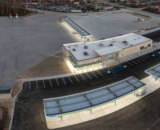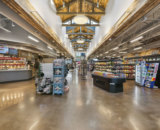Food service is becoming a more important component of the overall sales at truckstops and travel plazas, and today’s customers are demanding greater quality and convenience in the food they purchase. To be successful in food service, operators need to look at several aspects of their business, including their current offerings, their current customer demographics, and the wants and needs of customers they hope to capture.
“Truckers stop two to four times other than when they are fueling. Capturing those stops can bring the highest profitability for independents,” said Jim Fisher, founder and chief executive officer of the market research firm IMST Corp.
Evaluating Existing Offerings
The first step to growing a food service program is for truckstop and travel plaza operators to understand the success of their current food programs, said Darren Schulte, vice president of membership for NATSO. To do that, operators should compare fuel gallon sales to food service sales.
“Are the customers that are fueling with you coming inside and eating with you? Make a connection so you understand what a customer means to your inside,” Schulte said, adding that operators can compare fuel sales to coffee, grab-and-go or full-service restaurant sales.
Schulte said that locations vary, so there is no “right number” when it comes to the ratio of fuel and food service purchases. Simply having a number gives operators a place to start. “Once you have it, start examining it as you make changes,” Schulte said.
Even programs that are doing well should consider how they’re going to transform in the future. “The food service industry is all about change and what is current and what is hip,” said Michael Lawshe, president of Paragon Solutions. “You have to be evolving.”
Because there are so many aspects to a food service program, knowing where to make changes can be challenging.
Lawshe said that often times, operators don’t know exactly where to start. “They say, ‘Maybe I’ll make it pretty or change the booths or add chicken.’ There are a lot of maybes, and the challenge is to do away with what is easiest and what is most convenient and do the work to determine what is best for your location,” he said.
Before operators can determine how they’re going to grow their food service, they need to have a good understanding of what they want to accomplish and whether or not they can commit to it, Fisher said.
“Understand within your organization if you’re capable of handling a strong food service program or if you’d be best served to go the franchise route or go the lease route,” Fisher said. “The first step is to take a hard-core analysis of your organization and establish if you can do this and do it successfully.”
Understanding the Customer
Lawshe said growing food service always comes back to who the customer is. “You want to understand who your customer is today and what your customer base could be,” he said, adding that data is the key to understanding existing and potential customers along with how their needs are changing.
Among professional drivers, speed has become more important as hours-of-service regulations have changed. Michael Ouimet, president of Ouimet Resources, which operates travel center restaurants in 11 states and provides consulting work, said that, on average, a long-haul, regular route trucker is only eating one full-service meal every other day. “Fifteen years ago that was two full-service meals a day,” he said.
Not only are today’s drivers pressed for time, the younger generations have grown up with quick-serve brands. “For that generation, if they weren’t eating fast food three or four times a week, it was unusual,” Ouimet said.
In addition to looking at existing sales, operators should ask fuel customers where they are buying their inside purchases, Fisher said. “I think retailers should be constantly surveying their customers,” he said.
“Getting customer feedback is critical, but that only gives you insight into the existing customer,” Lawshe said.
To help understand customers, Lawshe often obtains studies from IMST or other groups that do statistical analysis. “There are so many layers that you can dig deeper into,” he said. “Often times it will say there are preferences toward this type of food—Mexican or pizza—and this demographic is in the area.”
Fisher said, “There is data out there that takes the buying habits of the residents and locals and shows where they’re spending their money. We will also do a study that shows within trade areas with similar characteristics to this trade area, on a national basis, where consumers are spending their dollars—pizza, chicken, sandwiches.”
Rather than take a “build it and they will come” approach, Fisher said locations should cater to the demographic. “Trade areas dictate what will be sold,” he said, adding that trade areas are constantly changing. “After 10 years, the trade area you built to serve is very different and you better be adjusting, too.”
Lawshe said examining potential customers is important for future growth. “It isn’t just who you’re getting today, it is who you are missing today that you have to find,” Lawshe said. “Once you understand that profile, you can look operationally at a whole series of questions.”
Tracking Current and Future Trends
Across the board, the current trend is toward freshly prepared, quality food. “Years ago drivers who were surveyed would tell you they were eating better, but then they’d go and buy the double cheeseburger in the restaurant. There is a group now that is going to encourage all of us to step up our game on freshness and flavor,” Ouimet said. “I think that locations that have really good full-service restaurants are going to get a little bit of a bump because the guys who are eating that one full-service meal are looking for something real and homemade. They’re looking for something special.”
Fisher said that in recent years, fast food chains, such as Wendy’s, McDonalds and Burger King, have lost their edge. McDonalds reported an 11 percent decrease in revenue and a 30 percent drop in profits for the first three months of year. The chain also announced that it had closed 350 poorly performing stores in Japan, the United States and China in the first three months of 2015, and Fisher said this type of performance is creating opportunities for truckstop and travel plaza operators.
Ouimet said he is seeing sales of healthy grab-and-go items increase. Salads, fresh fruits and vegetables, hard boiled eggs and deviled eggs are flying out of his grab-and-go cases. Sapp Bros. Travel Centers has seen its food sales increase, particularly in the grab-and-go arena. Sapp Bros. operates a proprietary restaurant, Apple Barrel, at six travel centers. “We have quality ingredients and are proud of what we serve. When we talked about how that translates into grab and go, we wanted that quality to carry over,” said Jeff Ryan, director of merchandising for Sapp Bros.
Sapp Bros. began preparing and packaging grab-and-go foods in its restaurant that it could offer in its c-stores. “We do hot meals along with sandwiches and salads and yogurts,” Ryan said. “The grab and go continues to sell very well and increases month over month continuously.”
What’s more, the grab-and-go sales haven’t led to a decrease in restaurant sales, Ryan said. “It is all incremental sales. There are two different customer bases—one that has time to sit down and enjoy a meal with us and one who wants a quality meal and doesn’t have time to sit down and enjoy it,” he said.
Ryan said the hot to-go specials depend on the daily special in the restaurant. “We prepare the same special of the day and put them in to-go packages where the products are labeled and clearly seen and available on the self-serve hot cases,” he said, adding that they take the same meal, chill it and sell it cold in the c-store for drivers to re-heat later.
The restaurant also prepares desserts to go. “It seems like even the customers who want to eat healthy five days a week want to indulge every once in a while. It is human nature,” Ryan said.
When it comes to packaging food, Ryan said Sapp Bros. uses clear containers and labels, which are important so customers know what they’re getting and when it was prepared. “It builds confidence within that transaction,” he said. “We concentrate on freshness and early on we said we wouldn’t worry about waste but focus on providing freshness.”
Unfortunately, shrink is simply part of doing business within the fresh category. Ryan said, “Over time, if you always provide fresh products, your self-branding builds and sales grow. As your sales build, the waste goes down.”
Fisher said, “People are afraid of shrink, but it becomes a part of doing business. To offer fresh, if it says use by such and such, get rid of it after that. If it says 12:20 and it is 12:30, dump it.”
Fisher added that proprietary programs, such as Sapp Bros.’, hold the most potential for profits. Ouimet said that one challenge for independent operators has been that they haven’t always documented their programs.
“You might have Betty Lou who makes great sandwiches and is doing great, but then Betty Lou leaves and the program dies. More operators are starting to put together more documentation because they realize the program is only as good as the documentation that goes with it,” he said.
Optimizing Offerings
Schulte said once operators understand who their customers are and what they want, they can consider making over their menus.
But evolving doesn’t mean simply adding to the menu. “People in our industry tend to let their menu grow, but they don’t cut anything. For everything you add to the menu, you probably should be taking something off,” Lawshe said.
Fisher said, “You have to evaluate and say, ‘Is this still a viable product to have?’”
To make the most of their menus, Schulte recommends operators look at customization rather than growing their SKU counts. “It is the 80-20 rule. Figure out the 20 percent of the products in the food service that you sell the most of and expand on those,” Schulte said. “You can focus on your chili and put chili on Frito’s or hot dogs or spaghetti. It is the customization that matters.” [Customization is also important in a location’s beverage offering. See related story Customization + Variety = The Future of Truckstop Beverage Sales].
In some cases, remaining successful means finding a new way to take on a traditional offering. “Our industry loves the full breakfast and all that it entails, but there are many ways to do that,” Lawshe said.
Instead of having wait staff take orders, operators could have customers order at the counter, then have the food delivered to the table. “It is more like the Panera Bread model—you go through the line, you have a full menu, you order and then they bring it to you. There are a lot of efficiencies in doing that,” Lawshe said.
Taking a Holistic Approach
While the food and presentation within a food service area is a primary driver of a program, Fisher said locations have to look at their overall operations when looking to increase sales.
“If you have great food service but your price sign has dirt behind the numbers and your dispensers are filthy, that’s not going to promote food service,” Fisher said.
Curb appeal is crucial for interstate locations. “Appearance gives you the ability to bring that customer in for the first time, but an appearance is like an Army recruiter—it will only get you once. To have a behavioral, habitual change, you have to have that total experience for customers,” he said.
Photo Credit: Ira Wexler/NATSO
|
This article originally ran in Stop Watch magazine. Stop Watch provides in-depth content to assist NATSO members in improving their travel plaza business operations. The magazine is mailed to NATSO members bimonthly. If you are a member and not receiving Stop Watch, submit a request to be added to the mailing list. Not a member? Join today or submit a request to receive additional information. |
Subscribe to Updates
NATSO provides a breadth of information created to strengthen travel plazas’ ability to meet the needs of the travelling public in an age of disruption. This includes knowledge filled blog posts, articles and publications. If you would like to receive a digest of blog post and articles directly in your inbox, please provide your name, email and the frequency of the updates you want to receive the email digest.


